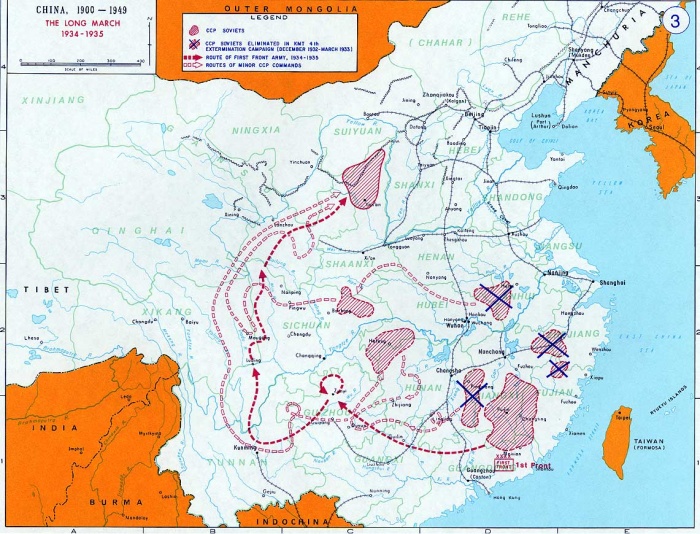Displaying image 307 of 467 images in History.
The Long March
1934: with the Communists facing annihilation by the Kuomintang, the army of the Communist Party of China retreated to the north of China during the 8,000-mile Long March.
Map Source: West Point Academy
Note: the map mentions "soviets." A "soviet" was an organized group of Communists, typically a local workers' council. The Soviet Union was named for a national union of soviets.
Following the collapse of the imperial Qing dynasty in 1911, China became fragmented, with warlords controlling various parts of the country. In the following years, two political parties emerged as rivals capable of unifying the country: the Kuomintang (KMT), a revolutionary nationalist party, and the Communist Party of China (CPC).
At first, the KMT and CPC joined forces to form a united front against the warlords. Yet as the alliance wrested more and more control of China away from the warlords, the ideological differences between the nationalist and communist factions grew. The nationalist KMT faction had become more powerful, and forced the Communists out of the alliance. Facing persecution, the CPC went underground, and fomented revolts, rebellions and uprisings. The Nanchang Uprising of 1927 became the starting point of a ten-year civil war.
Famously, in 1934, with the Communists facing annihilation by the KMT, the army of the CPC retreated to the north of China during the 8,000-mile Long March.
» View larger image
Map of The Long March
Over 80,000 people set out, and fewer than 10,000 people survived. Nevertheless, these survivors became the core around which the Party rebuilt itself in later years. In fact, a key leader during the Long March was Mao Zedong. And, just as importantly, the peasants of the country who heard of the Communists' survival now saw them in a heroic light.
In 1937, the KMT, led by Chiang Kai-shek, was forced to contend with the invasion of China by the Japanese. The Chinese unified once more to defend against the invasion and occupation, until Japan's defeat at the end of World War II. Wartime resistance against the Japanese greatly weakened the KMT. The Communists, meanwhile, ever champions of workers and peasants, were further able to garner support among the Chinese peasant class, who had been oppressed by the Japanese during the War.
With the end of World War II, the Chinese civil war resumed. American negotiators stepped in to resolve the conflict between the KMT and the CPC, and both sides agreed to reduce their troop levels. The CPC reduced its troop levels through political purges. Meanwhile, the KMT simply fired their 1.5 million soldiers, who, though alive, now had no livelihood. The millions of unemployed soldiers turned to the CPC for employment.
Building on the popular support gained during the Long March and World War II, and reinforced by this new influx of disgruntled military manpower, the CPC was then in position to rout the weakened KMT. On October 1, 1949, Mao Zedong declared the establishment of the People's Republic of China, a single-party state under control of the Communist Party of China.
Defeated, the KMT survived by retreating to Taiwan. To this day, the Kuomintang continues to call Taiwan its home, and no treaty has ever been signed to officially end the Chinese civil war.
Led by Mao Zedong, the People's Republic of China was reorganized along Communist lines. Ambitious revolutionary programs such as the Great Leap Forward (1958-60) and the Cultural Revolution (1966-76) aimed to thrust China forward on economic, political and cultural fronts, while dispensing with tradition.
However, these programs had disastrous consequences. As a result of rural land reforms and ineffective agricultural policy, massive famines broke out during the Great Leap Forward. As many 30 million people died as a result of starvation.
The Cultural Revolution was meant to further the revolutionary ideals and eliminate political rivals, but its widespread political turmoil led to economic, intellectual and cultural stagnation. It was also a period of repression and paranoia, which Mayfair Yang describes as a "reign of terror." Author Anchee Min spent time in a forced-labor camp in her teens, and spoke to Krista about life during the Cultural Revolution and the "cult of Mao" in a previous Speaking of Faith program.
After the death of Mao Zedong in 1976, subsequent generations of Party leaders instituted economic reforms that paved the way for China's surging industrialization.
Source: http://speakingoffaith.publicradio.org/programs/chinese_religiosities/particulars.shtml
For more information about the CPC Revolution, please check the documentary Mao's Bloody Revolution Revealed



 Searching...
Searching...

 Previous
Previous
 Next
Next